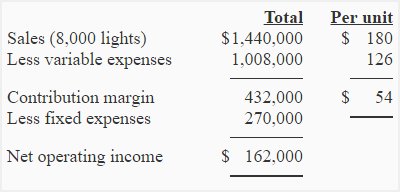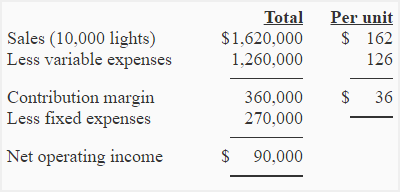Exercise-1 (Target profit analysis, break-even point)
PNG Electric Company manufactures a number of electric products. Rechargeable light is one of the PNG’s products that sells for $180/unit. Total fixed expenses related to rechargeable electric light are $270,000 per month and variable expenses involved in manufacturing this product are $126 per unit. Monthly sales are 8,000 rechargeable lights.
Required:
- Compute the break-even point of PNG in both dollars and units.
- According to a research conducted by sales department, a 10% reduction in sales price will result in 25% increase in unit sale. Prepare two income statements in contribution margin format, one using the current price and one using proposed price (10% below the old sales price).
- Compute the number of rechargeable lights to be sold to earn a net operating income of $189,000 per month (use original data).
Solution:
(1). Computation of break-even point:
a. Break even point in units:
Break even point in units can be computed by using either equation method or contribution margin method. Both the methods are given below:
i. Equation method:
The equation to calculate break even point is:
SpQ = VeQ + Fe
Where;
- Sp = Sales price per unit.
- Q = Number (or quantity) of units to be manufactured and sold during the period.
- Ve = Variable expenses to manufacture and sell a single unit of product.
- Fe = Total fixed expenses for the period.
Let’s apply this equation to calculate the break even point of PNG.
SpQ = VeQ + Fe
$180Q = $126Q + 270,000
$180Q – $126Q = $270,000
$54Q = $270,000
Q = $270,000/$54
Q = 5,000 units
PNG needs to sell 5,000 units to break even.
Alternatively, we can obtain the same answer by using the contribution margin method as follows:
ii. Contribution margin method:
Break even point = Fixed expenses/Contribution margin per unit
= 270,000/54*
= 5,000 units
*$180 – $126
b. Break-even point in dollars:
Break-even point in dollars can be computed by simply multiplying the break even point in units by the sales price per unit as shown below:
Break even point in dollars = BEP in units × Sales price per unit
= 5,000 units × $180
=$900,000
(2) Income statements:
a. Income statement under current operations:

b. Income statement under proposed operations:

The proposal should not be accepted because it will reduce the contribution margin from $54 per unit to $36 per unit and net operating income from $162,000 to $90,000.
(3) Target profit analysis:
a. Equation method:
The equation to calculate the number of units to be sold to generate a target profit is:
SpQ = VeQ + Fe + Tp
Where;
Sp = Sales price per unit.
Q = Number (quantity) of units to be manufactured and sold during the period.
Ve = Variable expenses to manufacture and sell a single unit of product.
Fe = Total fixed expenses for the period.
Tp = Target profit for the period.
Let’s apply this equation to calculate the number of units to be sold to earn a profit of $189,000.
SpQ = VeQ + Fe + Tp
$180Q = $126Q + 270,000 + $189,000
$180Q – $126Q = $459,000
$54Q = $459,000
Q = $459,000/$54
Q = 8,500 units
On the basis of original data, company needs to sell 8,500 rechargeable lights to earn a profit of $189,000.
Alternatively, we can obtain the same answer by applying the contribution margin method as follows:
b. Contribution margin method:
(Fixed expenses + Target income)/Contribution margin per unit
= ($270,000+$189,000)/54
= 8,500 units

Leave a comment